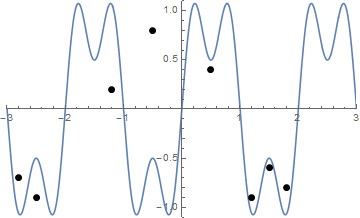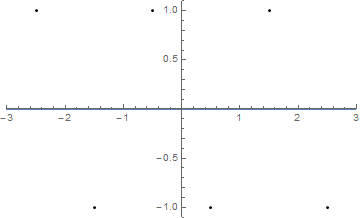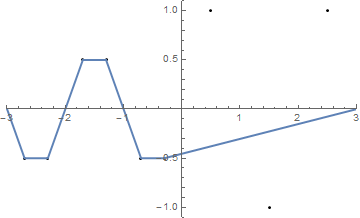21
2
Let's plot a function f(x) = sin(πx) + 0.5 sin(3πx) over the domain [-3,3]. We can interpret this as a loose string lying on a board. Now let's drive n nails into the board at positions (x1, y1) to (xn, yn), where the xi ∈ (-3,3) and yi ∈ [-1,1]. Imagine that there are two eyelets at the end of the string, that is at positions (-3,0) and (3,0). We can now take the ends of string and pull the through the eyelets until the string is taut. This will deform our graph into a piecewise linear function.
Some pictures might help. Take 8 nails at (-2.8, -0.7), (-2.5, -0.9), (-1.2, .2), (-0.5, .8), (0.5, .4), (1.2, -0.9), (1.5, -0.6), (1.8, -0.8). The following three plots show the process described above:

For larger version: Right-click --> Open in new tab
And here is an animation of the string tightening if you have some difficulty visualising it:

The Challenge
Given a list of "nails" (which is not necessarily sorted), plot those nails and the taut string if it starts from the shape of the above function f.
You may write a program or function and take input via STDIN, ARGV or function argument. You can either display the result on the screen or save an image to a file.
If the result is rasterised, it needs to be at least 300 pixels wide and 100 pixels tall. The coordinate range from (-3,-1.1) to (3,1.1) must cover at least 75% of the horizontal and vertical extent of the image. The length scales of x and y do not have to be the same. You need to show the nails (using at least 3x3 pixels) and the string (at least 1 pixel wide). You may or may not include the axes.
Colours are your choice, but you need at least two distinguishable colours: one for the background and one for the nails and the string (those may have different colours though).
You may assume that all nails are at least 10-5 units away from f (so that you don't need to worry about floating-point inaccuracy).
This is code golf, so the shortest answer (in bytes) wins.
More Examples
Here are two more (simpler) examples:
{{-2.5, 1}, {-1.5, -1}, {-0.5, 1}, {0.5, -1}, {1.5, 1}, {2.5, -1}}

(The string coincides with the x-axis.)
{{-2.7, -0.5}, {-2.3, -0.5}, {-1.7, 0.5}, {-1.3, 0.5}, {-0.7, -0.5}, {-0.3, -0.5}, {0.5, 1}, {1.5, -1}, {2.5, 1}}




Can we assume that the nails are sorted from left to right? – Ell – 2014-09-30T07:26:03.127
@Ell Ah, good catch. Since I haven't specified it to begin with, no. I'll clarify that. – Martin Ender – 2014-09-30T07:40:28.450